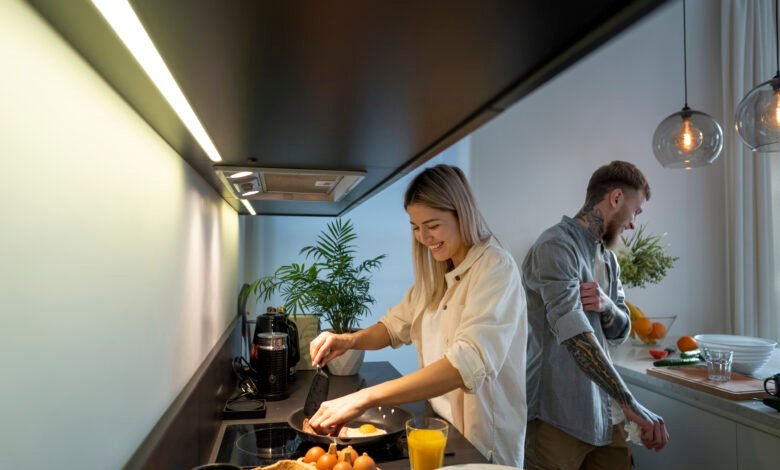Commercial Kitchen Lighting: Illuminating Safety, Efficiency, and Ambiance

In the high-stakes, fast-paced environment of a commercial kitchen, lighting is far more than a mere afterthought—it’s a critical operational backbone. Effective illumination ensures precision in food preparation, enhances staff safety, streamlines workflow efficiency, and even subtly influences customer perception in open-display kitchens. Yet, too often, lighting is relegated to basic overhead fixtures, neglecting its profound impact on everything from accident prevention to energy costs. This article explores how strategic lighting design transforms chaotic kitchens into optimized, compliant, and productive culinary engines, balancing technical requirements with human-centric needs to create spaces where both food and functionality shine.
1. The Foundational Role of Task Lighting
Task lighting is the cornerstone of any commercial kitchen, delivering intense, focused illumination precisely where staff perform intricate, high-risk activities like chopping, grilling, or plating. Unlike ambient lighting, task fixtures—such as under-cabinet LED strips, pendant lights over prep stations, or recessed downlights above grills—must eliminate shadows and glare while providing high color rendering (CRI >90) to ensure accurate visual assessment of food quality and safety (e.g., spotting undercooked meat or contaminants). The recommended illuminance level for these zones ranges from 500 to 1,000 lux, dwarfing standard office lighting. Without this precision, errors multiply: knife slips increase, sanitation checks fail, and presentation consistency suffers, directly impacting operational safety and customer satisfaction.
2. Ambient and Safety Lighting: Beyond the Workstation
While task lighting targets specific zones, ambient lighting provides uniform background illumination, reducing harsh contrasts and preventing disorientation during rapid movement. This layer typically involves vandal-resistant ceiling panels or wraparound fixtures with diffusers to soften shadows. Crucially, safety lighting integrates seamlessly here, featuring emergency battery backups that activate during power outages, guiding exits via illuminated pathways. Non-slip flooring and reflective surfaces (like stainless steel) amplify ambient light’s effectiveness, while fixtures must be rated IP65 or higher to withstand grease, steam, and frequent washdowns. Neglecting ambient balance risks creating “cave effects,” where overly bright task areas blind staff transitioning to dimmer zones, increasing trip hazards.
3. Energy Efficiency and Sustainable Solutions
Modern commercial kitchens increasingly turn to LEDs—consuming 75% less energy and lasting 3–5× longer than halogens or fluorescents—to slash utility bills and maintenance downtime. Smart systems elevate savings further: motion sensors deactivate lights in storage areas, while dimmable zones adjust brightness based on daylight ingress or operational shifts. Thermal management is vital, as heat-sensitive LEDs require robust heat sinks near ovens. Beyond cost, sustainability aligns with brand values: ENERGY STAR-certified fixtures reduce carbon footprints, while targeted spectral tuning (e.g., cooler 5000K lights for alertness during peak hours, warmer 3000K in dining areas) optimizes human circadian rhythms.
4. Compliance with Health and Safety Regulations
Lighting in commercial kitchens isn’t optional—it’s governed by stringent codes like NFPA 96 (fire safety), OSHA’s minimum 500 lux requirement for prep surfaces, and FDA Food Code standards mandating shadow-free zones for hygiene inspections. Fixtures must be completely sealed to prevent debris ingress, feature shatterproof lenses to avoid glass contamination, and avoid toxic materials (e.g., mercury in old fluorescents). Placement is equally regulated: lights over open food must have protective covers, and emergency exits require path-marking luminaires. Non-compliance risks fines, failed inspections, or liability in accidents, making collaboration with lighting specialists familiar with local codes non-negotiable.
5. Psychological and Ergonomic Impacts on Staff
Lighting profoundly influences kitchen staff morale and performance. Poorly designed systems—flickering bulbs, uneven coverage, or excessive glare—cause eye strain, headaches, and fatigue, escalating errors during long shifts. Conversely, circadian-friendly designs mimic natural light patterns, boosting alertness and reducing turnover. Ergonomically, vertical illuminance (lighting on walls and faces) improves non-verbal communication during high-noise service rushes. For open kitchens, aesthetic cohesion matters too: sleek, low-profile fixtures maintain a professional ambiance visible to diners, reinforcing brand prestige. Investing in staff well-being through lighting isn’t just ethical—it’s economically savvy, reducing training costs linked to burnout.
FAQ Section
Q1: How often should commercial kitchen lights be replaced?
LEDs typically last 50,000–100,000 hours but schedule quarterly inspections for grease buildup, which can reduce output by 30%. Replace any flickering or dimming fixtures immediately to maintain compliance.
Q2: Can I use residential lighting fixtures in a commercial kitchen?
No. Commercial-grade fixtures have higher IP ratings for moisture/grease resistance, thermal durability, and compliance with safety standards like UL 1598/UL 844. Residential units fail rapidly under kitchen demands.
Q3: What color temperature (Kelvin) is best for food prep?
Opt for 4000K–5000K (cool white to daylight). This range enhances visual clarity for intricate tasks and accurately renders food colors, crucial for quality control.
Q4: Are smart lighting controls worth the investment?
Absolutely. Automated dimming, occupancy sensors, and zone-based systems reduce energy waste by 40–60% and allow customization for shift changes, yielding ROI in 1–3 years.
Conclusion
Commercial kitchen lighting transcends basic visibility—it’s an intricate ecosystem intertwining safety, efficiency, human psychology, and regulatory rigor. From the surgical precision of task lighting over a chef’s station to the life-saving glow of emergency exit signs, every lumen serves a purpose. Investing in layered, adaptive LED systems with smart controls doesn’t just prevent accidents and ensure compliance; it fuels staff well-being, slashes operational costs, and elevates the culinary artistry that defines a successful establishment. In an industry where margins are thin and risks are high, superior lighting is the silent guardian of both profit and people, proving that brilliance belongs not just on the plate, but above it.


